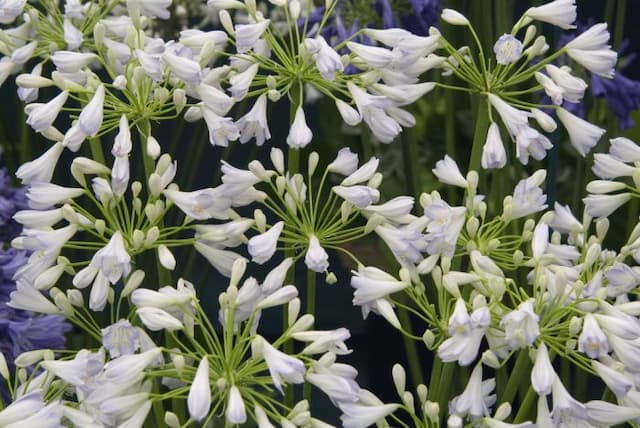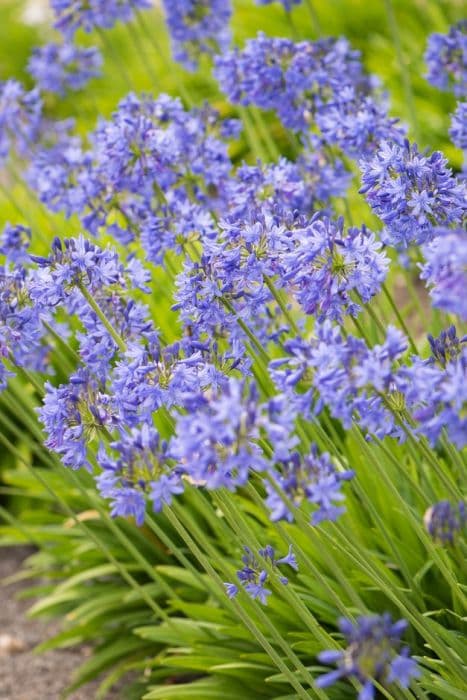African Lily Agapanthus 'Stockholm'

ABOUT
Agapanthus 'Stockholm', commonly known as the African Lily or Lily of the Nile, is an ornamental perennial. This plant is notable for its striking flowers which bloom at the top of sturdy, upright stems. The flowers are typically a rich, vivid blue or purple, arranged in globular clusters, often giving the appearance of a fireworks display. Each cluster, or umbel, is made up of a multitude of smaller, trumpet-shaped individual flowers that gracefully emerge in a circular pattern. The foliage of the African Lily is also quite attractive. It consists of long, slender straps or ribbons of green leaves that form a dense clump. These leaves are glossy, with a smooth texture that emanates from a central base, arching outwards and creating a lush, vibrant green backdrop that nicely contrasts the bold hues of the blossoms. The plant's overall shape tends to be mounded or slightly rounded, with the flower stems rising prominently above the foliage, giving the floral display a proud and elevated presence. The aesthetic appeal of Agapanthus 'Stockholm' lies in its elegant yet dramatic flower heads and its graceful, fountain-like foliage which together create a visually compelling display in the garden or when used in containers or borders.
About this plant
 Names
NamesSynonyms
African Lily, Lily of the Nile, Love Flower
Common names
Agapanthus 'Stockholm'.
 Toxicity
ToxicityTo humans
The plant commonly known as Lily of the Nile can be toxic to humans if ingested. Although the level of toxicity is generally considered to be low, the ingestion of any part of the plant can lead to gastrointestinal discomfort, including symptoms such as nausea, vomiting, and diarrhea. In some cases, skin contact with the sap may cause irritation or an allergic reaction.
To pets
Lily of the Nile is also toxic to pets, including dogs and cats. If pets ingest parts of this plant, they may experience symptoms such as nausea, vomiting, and diarrhea. In severe cases, ingestion can lead to tremors or cardiac arrhythmia. It is important to keep pets away from this plant to prevent the risk of poisoning.
 Characteristics
CharacteristicsLife cycle
Perennials
Foliage type
Evergreen
Color of leaves
Green
Flower color
Blue
Height
2 feet [60 cm]
Spread
2 feet [60 cm]
Plant type
Bulb
Hardiness zones
8
Native area
South Africa
Benefits
 General Benefits
General Benefits- Ornamental Appeal: The Agapanthus 'Stockholm', commonly known as Lily of the Nile, offers beautiful clusters of blue or white flowers that enhance the visual appeal of gardens and landscapes.
- Low Maintenance: This plant requires minimal care once established, making it a convenient choice for busy gardeners.
- Drought Tolerance: It is relatively drought-tolerant, making it suitable for dry climates and water-wise gardens.
- Long Blooming Season: The Lily of the Nile typically enjoys a long blooming period, providing color and interest in the garden for an extended time.
- Attracts Pollinators: The flowers can attract bees, butterflies, and other pollinators, supporting local ecosystems.
- Deer Resistance: It is known to be resistant to deer, which makes it an excellent choice for areas where deer predation is a problem.
- Versatility: Suitable for borders, pots, and as cut flowers, adding versatility to its uses in landscaping and home decor.
 Medical Properties
Medical PropertiesThis plant is not used for medical purposes.
 Air-purifying Qualities
Air-purifying QualitiesThis plant is not specifically known for air purifying qualities.
 Other Uses
Other Uses- Biodegradable Dye Source: The deep blue blooms of the Agapanthus 'Stockholm' can be used to create biodegradable dyes for fabric coloring.
- Photography Backdrops: Due to their large and attractive flower heads, Agapanthus 'Stockholm' plants can be used as natural backdrops for portrait photography.
- Garden Borders: The plant's uniform growth habit makes it an ideal choice for creating clear and ornamental garden borders.
- Educational Tool: Agapanthus 'Stockholm' can be used in educational settings to teach about plant reproduction and pollination as they attract various pollinators.
- Floral Art: The long stems and spherical flower clusters of the Agapanthus can be used in floral art and ikebana, a Japanese art of flower arrangement.
- Mood Setting: The presence of Agapanthus 'Stockholm' in an outdoor dining area or around a patio can set a calming and sophisticated mood for guests.
- Erosion Control: The root system of the Agapanthus 'Stockholm' can help stabilize soil and prevent erosion on sloped landscapes.
- Feng Shui: In feng shui, Agapanthus 'Stockholm' with its rounded flower shapes can be utilized to bring a sense of fluidity and softness to garden spaces.
- Culinary Garnish: Although not widely recognized as an edible flower, the blooms may be used as a decorative garnish for special dishes in upscale culinary presentations.
- Conservation Awareness: Agapanthus 'Stockholm' can be showcased in conservation gardens to highlight the importance of biodiversity and native flora.
Interesting Facts
 Feng Shui
Feng ShuiThe Lily of the Nile is not used in Feng Shui practice.
 Zodiac Sign Compitability
Zodiac Sign CompitabilityThe Lily of the Nile is not used in astrology practice.
 Plant Symbolism
Plant Symbolism- Love Letters: The name "Agapanthus" is derived from the Greek words 'agape' meaning love, and 'anthos' meaning flower. The 'love' aspect can symbolize an expression of admiration or a romantic gesture akin to love letters.
- Beauty: Known for their striking blue or purple flowers, agapanthus are often associated with beauty that stands out in any setting, making them a symbol of unique and eye-catching attractiveness.
- Endurance and Survival: Agapanthus can grow in a variety of conditions and are relatively hardy. This has led to them symbolizing endurance and the ability to survive and thrive in the face of adversity.
- Fertility and Pregnancy: Sometimes linked to fertility due to their lush and bountiful floral displays, the agapanthus can be seen as a celebration of new life or as a good omen for those hoping to conceive.
 Water
WaterAfrican Lilies should be watered deeply when the top inch of the soil feels dry to the touch, which typically occurs once a week during the growing season. Gradually reduce watering frequency in the fall and water sparingly during the winter when the plant is dormant. In general, about one to two gallons of water should suffice for an established plant each time you water, ensuring that the soil becomes saturated but not waterlogged. During hot, dry periods, additional watering may be necessary, but always check the soil moisture first to avoid overwatering.
 Light
LightAfrican Lilies thrive in full sun to partial shade. The ideal spot for this plant would be a location where it receives at least six hours of sunlight a day, although some afternoon shade can be beneficial in extremely hot climates. The plant will flower best in full sun, so place it in a spot where it can receive ample bright, indirect light throughout the day for optimal growth.
 Temperature
TemperatureAfrican Lilies prefer temperate climates and do best in temperatures ranging from 50 to 80 degrees Fahrenheit. While they can tolerate temperatures down to about 50 degrees Fahrenheit, they should be protected from frosts and freezes. The ideal temperature range for optimal growth and flowering is between 60 and 70 degrees Fahrenheit. If outdoor temperatures exceed this range, providing some shade during the hottest part of the day can help to prevent heat stress.
 Pruning
PruningAfrican Lilies benefit from pruning to remove spent flower stalks and encourage new growth. Cut back the flower stems to the base after blooming to tidy up the plant and promote a second flush of flowers. Prune any damaged or dead leaves as needed throughout the year to maintain the plant's appearance. The best time for major pruning is early spring before new growth starts.
 Cleaning
CleaningAs needed
 Soil
SoilAfrican Lily 'Stockholm' thrives best in a soil mix that is rich in organic matter, and has excellent drainage. The ideal pH for this plant is between 6.0 and 7.0. A mixture of loam, compost, and sharp sand or perlite is recommended to promote healthy root growth and optimal flowering.
 Repotting
RepottingAfrican Lily 'Stockholm' generally needs to be repotted every 2 to 3 years to refresh the soil and provide more room for growth. It is best to repot in the spring before the growing season begins. This schedule ensures the plant remains vigorous and blooms are maximized.
 Humidity & Misting
Humidity & MistingAfrican Lily 'Stockholm' is adaptable to a wide range of humidity levels but prefers moderate to high humidity. Providing a humidity level between 40% and 60% is ideal for this plant to thrive.
 Suitable locations
Suitable locationsIndoor
Place in well-lit area avoiding direct midday sun.
Outdoor
Plant in partial shade with well-draining soil.
Hardiness zone
8-11 USDA
 Life cycle
Life cycleThe life of Agapanthus 'Stockholm', commonly known as Lily of the Nile, begins with seed germination, which occurs in warm, moist soil where the seed develops into a small seedling. After germination, the seedling grows into a vegetative state, developing long, strappy leaves and forming a clump-like growth habit. As the plant matures, it develops a strong root system and in the right conditions, will produce tall flower stalks, which bear rounded clusters of blue or purple flowers typically during the summer months. After flowering, seed pods may form, which eventually dry and release seeds if not deadheaded, continuing the reproductive cycle. During autumn or cold weather, the plant may become dormant, with growth slowing or stopping and foliage dying back, especially in cooler climates. With the return of warmer weather and adequate water, the plant resumes growth, completing its perennial cycle.
 Propogation
PropogationPropogation time
Spring-Early Summer
Propogation: For the Agapanthus 'Stockholm', commonly known as Lily of the Nile, the most popular method of propagation is by division of the plant's clumps. This is typically done in the spring or early summer when the plant is starting to grow actively. The process involves gently removing the plant from the soil and separating the clumps into smaller sections, ensuring that each new section has a portion of the roots attached. These divisions can then be replanted in well-draining soil, spaced about 12 to 18 inches (approximately 30 to 45 centimeters) apart to give them ample room to grow. The divided plants should be watered in well after planting to help establish them in their new location.









